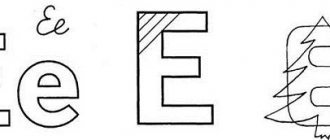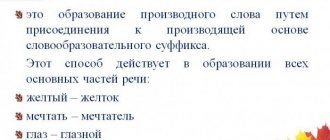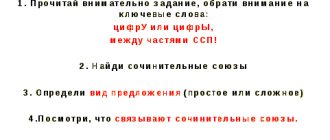Declension of participles. Spelling vowels in case endings of participles
· Today in class we will talk about the declension of participles.
· Let's find out what endings the participles have when declension.
· Let's learn how to decline participles.
We have already met the sacrament.
The participle denotes the attribute of an object by action, manifested in time: running, walking, wearing.
The participle, like the adjective, answers the questions which? which? which? which?
Just like an adjective, a participle agrees with nouns in gender, number and case: kitten
– which one?
- surprised
.
But today we are interested in one more ability of the participle, inherited from the adjective: participles are declined
, that is,
they change by gender and by case
.
Nominative case – anyone? − flying bird
Prepositional case - dream about whom? - about a flying bird.
To see exactly how we determine the case endings of participles, let's inflect one of them together with a noun and an adjective.
I.p. – is there anyone? running
red fox
R.p. _ _ - no one? running to her red
fox .
D.p. - give cheese to whom? running to her
red to her fox
V.p. see who? running red
fox
etc. _ _ – the cheese was stolen by whom? running to her
red to her fox
P.p. - talk about whom? - about the
red fox running .
You and I see that the endings of an adjective and a participle differ very slightly in declension. For example: the fox is running
and red
UYU
.
But do you remember how we determine the endings of adjectives? We pose a question to them. Here we can ask : which fox
?
It turns out that the case endings of participles, like the endings of adjectives, are determined using a question. This means that the end of the participle will always be equal or approximately equal to the end of the question.
To see this, let's try to decline a participle and a masculine
, while keeping an eye on the endings.
So:
I.p. - Who? lying fat
cat
R.p. _ _ - no one? lying his
fat cat
D.p. _ - approach whom? the
fat cat
V.p. lying on him. see who? lying his
fat
cat _
etc. – the mouse was caught by whom? lying to them
as a fat cat
P.p. - talk about whom? - about a lying fat cat
And now
we see that again the endings of the participle coincide or almost coincide with the endings of the adjective: lying IM
and thick
YM
(the difference is explained only by the soft and hard base of the words).
And again we can notice that the end of the participle also coincides with the end of the question: how IM
?
− recumbent MI
.
Let's see how things stand with neuter
.
Let's take a participle and an adjective: wrinkled funny face
. We decline:
I.p. - What is this? wrinkled funny
face
R.p. _ _ – what’s missing? wrinkled funny
face
D.p. _ _ – be surprised at what? wrinkled funny
face
V.p. _ _ see what? wrinkled funny
face
etc. _ _ – admire what? wrinkled funny
face
P.p. _ _ - talk about what? - about the wrinkled funny
face And
we see that the endings of the participle, adjective and question again coincide: faces AS OH
?
– wrinkled
OGO and
funny
OGO .
So now we are almost sure of our theory. But who knows how plural participles are declined? Let's do one more declination operation:
Let’s take a design that is already familiar to us: tired, quiet children
.
I.p. – is there anyone? tired ,
quiet children
R.p. _ - no one? tired of
their
quiet children D.p. – sing to whom? tired im
quiet im children yam
V.p. see who? tired of
their
quiet children etc. – play with whom? with tired ,
quiet children
P.p. _ - talk about whom? - about their
,
quiet children And we see that our endings again coincide: children - how are they
?
– tired of THEM
and quiet
of THEM
.
What do we need to remember?
The case endings of participles, like the case endings of adjectives, depend on the question and coincide with the endings of the question that we can put from nouns.
So, what should we do if we need to raise the participle to a certain case? We must put a question from a noun
.
And then look carefully at the question that we posed, and in accordance with it, determine the ending we need
.
Let's try our algorithm in action.
For example, we need to open the parentheses in the sentence: “I see ( a crying child
)".
We must put the phrase with the participle in the required form. We remember: see
is a transitive verb, it requires the accusative case.
So, I see who?
- child .
Child - how wow ? - crying him
.
Let's try again. He came over (busy grandmother).
You can approach
someone
.
This means that we have the dative case. Approach - to whom? – to grandma – to grandma how oh ? - busy oh .
Z
Let's consolidate success!
You heard (famous magician).
You can hear not only something, but also about someone.
Before us is the prepositional case. Have you heard about whom? – about the magician – oh how oh ? - about the illustrious one
.
Lesson summary “Declination of participles” in Russian
Declension of participles.
The purpose of the lesson:
to show the similarity of the declensions of participles and adjectives, to develop the ability to determine the conditions for choosing vowels in the endings of participles and adjectives.
During the classes.
I. _ Org moment.
II . Working with the class.
1. Checking homework
(Ex. 511). Students read sentences written out at home, naming gender, number, and case of participles.
2. Vocabulary dictation.
Repetition of spelling of adjectives, development of spelling skills.
To attend a scientific conference, thanks to excellent conditions, despite the hurricane wind, to drag along a dusty road, in a charming frame, in the morning light, a wonderful picture of returning home late on a stormy evening, the beauty of the spring lily of the valley, to take a breath of fresh frosty air
Presentation
No. 6. (SLIDE No. 1)
- Language warm-up.
Syntactic analysis of the sentence.
(SLIDE No. 2)
The world was renewed, blossomed, as if a huge, high, fragrant wave was sweeping across it.
(I. Evdokimov)
–Graphically explain the studied spellings.
III . Discovery of new knowledge.
- Write out the phrase high fragrant wave from the last sentence.
—
How do you check the spelling of the ending of an adjective?
- What about the sacraments? Try the same rule.
Table (SLIDE No. 3)
— Formulate a rule for spelling unstressed vowels in case endings of participles.
— Check your assumptions using the textbook (p. 280).
— Let’s write down the topic of today’s lesson in our notebook: “Declination of participles.”
(SLIDE No. 4)
IV . Development of spelling skills.
1)
Ex. 513 is performed in writing, with a board. Graphic symbols are made according to the model in the frame (p. 280).
2) Ex. 514 - in writing, independently, with subsequent verification.
V. _ Summing up the lesson. ( SLIDE No. 5)
— How do you check the spelling of unstressed endings of participles?
— Try to explain why the spelling of an unstressed vowel in case endings of participles is governed by the same rule.
VI . Homework. Ex.
522.
Declension of participles.
The purpose of the lesson:
to consolidate the skills of declension of participles,
to promote the development of students’ speech.
During the classes.
1. Checking homework (exercise 518).
2. Vocabulary dictation.
We develop spelling skills related to the studied spelling.
A cleared sandy shore, approaching clouds, by a seething mountain river, along a winding path, about melting snow, a visible road, living in a sultry desert, admiring a flying dove, banners fluttering in the wind, along an alley strewn with yellowed leaves, whispering reeds.
3. Development of spelling and speech skills.
1
) Ex.
515 is done in writing, participles are written out on the board with
the words to which they relate, with the designation of the spelling.
2) Ex. 516 - in writing, independently, with subsequent verification.
3) Ex. 517 - according to the instructions of the textbook. When performing this exercise, you should once again draw students' attention to the limited use of participles in speech (their almost complete absence in oral speech).
4. Summing up the lesson.
- Write down the key words of the lesson in the textbook (unstressed endings of the participle, identification mark, question for the participle).
Presentation
No. 7 (SLIDES No. 1 – 5)
5. Homework.
Create a task for a neighbor with gaps for the spelling pattern being studied (20 examples
).
(SLIDE No. 6)
6. Test work. (SLIDES No. 7 – 11)
"Declination of participles and spelling of vowels in case endings of participles."
Lesson summary of the Russian language in 7th grade on the topic:
"Declination of participles and spelling of vowels in case endings of participles."
The goals of the teacher’s activities: to introduce the declension of participles; contribute to the formation of the ability to determine the conditions for choosing vowels in the endings of participles and adjectives.
Lesson type: combined lesson
Methods and forms of teaching: problem-based method; activity-practical method; individual, group, frontal.
Organizational structure of the lesson.
- Greeting students.
- Poll on the previous topic of the lesson:
- What does the participle mean? (The participle denotes a characteristic of an object that occurs in time, as an action that the object produces, or as an action to which it is subjected by another object)
— name the signs of a verb and an adjective in a participle (signs of a verb in a participle: voice, aspect, tense, transitivity/intransitivity, reflexivity/irrevocability.
Signs of an adjective in a participle: changes by gender (only in singular), number.)
- name the syntactic role in the sentence (Syntactic role: definition (in full form) or predicate (in short form).
- how participles are declined (full participles are declined in the same way as full adjectives).
3. Independent work
Card No. 1. Write down phrases in the form of genitive, dative, instrumental and prepositional cases. Label the spellings being studied.
A proposed hike, a building under construction, a fluttering fish, a dozing old man, a barking dog.
Card No. 2. Rewrite, matching the participles with the words necessary in meaning. Make two sentences with any two phrases. Parse one of them.
From (overhanging) trees; view of a (fading) garden; on the (roaring) sea; along (lived) river; talk about 9 raging) blizzard; (under construction) buildings; watch (galloping) rider; in (solidifying) air; look at (painted) picture; cook (grated) vegetables; admire the (murmuring) stream; withdraw (raised) hand.
Card No. 3. Rewrite. Place the missing letters in the endings of the participles.
Decline any two phrases.
</ Улыбающ…ся ребёнка; о наступивш… лете; цветущ… яблоня; в зеленеющ… лесу; мчащ…ся река; у потухш… костра; в застывающ… воздухе; к расстроен… человеку; за ближайш… огородами; за летящ… стрелой; заросш… дорожка, на посветлевш… небе; в клокочущ… лаве; с провален… крыши; не закончен… работа.
4.Reading textbook material (working on questions)
— How is the declension of participles determined?
— What helps determine the declension of participles?
5. Fixing the material.
1. Decline these phrases. (students work at the board, the rest in notebooks)
Melting snow, spreading fog.
6. Reflection on educational material (lesson summary).
— What new did you learn in the lesson?
— How is the declension of participles determined?
— What helps determine the declension of participles
7. Homework (commented). (check the old and new textbook, learn the rule using the new P.13, exercise 82 on p. 36)
Download material
so UNT / Lesson plans for the Russian language / Lesson plans for the Russian language 7th grade
Lesson 21. Declension of participles and spelling of vowels in case endings of participles (practical work)
14.12.2011 22059 2343
Lesson 21. Declension of participles and spelling of vowels in case endings of participles (practical work)
Goals:
consolidate skills in declension of participles; promote the development of students' speech.
Methodical techniques:
linguistic analysis, oral presentations, implementation of interdisciplinary connections; independent work.
During the classes
I. Checking homework
1. Oral presentations by students and discussion of presentations. (Continuation of hearings.)
2. Checking the mastery of the material.
—What are the features of the declension of participles?
— How to choose a vowel at the end of a participle?
— What phrases are formed with the participation of participles?
3. Exercise 67: checking “chain by chain”, parsing is performed by one of the students on the board.
Additional question:
— Which work by Kuprin are the sentences taken from? (“ White
II. Consolidating the topic “Declination of participles”
1. Exercise 68: commented letter.
2. Work with textbooks of physics, history, geography (those that are in students’ portfolios): select and write down sentences with participles; make diagrams of phrases that include participles.
Note:
10 minutes are given for this work, after which the students read the written sentences and write down patterns of phrases with participles on the board.
3. Explanatory dictation. Syntactic parsing of sentences.
Students write down the text under dictation, underline parts of the sentence, and highlight phrases with participles.
Now only witnesses of its former greatness remain
-
castles, forts, gloomy palaces and a square massive tower crowning the city.
People with crossbows once sat at the loopholes, boiling tar was poured from the walls onto the enemies, stones flew overhead, fired from a distance of two hundred meters. Now there is
silence. walls and towers
all around (V. Nekrasov.)
Note:
The students have not yet studied punctuation marks for participial phrases, but you can ask them to try to explain all the punctograms.
Homework
1.§11.
2. Creative work: come up with a continuation of the text of the explanatory dictation or its beginning.
Additional task (complication): include sentences with participles in the essay.
See the downloadable file for the full text of the material.
The page contains only a fragment of the material.
Spelling vowels in participle suffixes
As a rule, mistakes are made when writing unstressed vowels in suffixes of present participles (formed from the present tense stem - the personal form of verbs of the 3rd person, plural, NV)
| What verbs are formed from | Active participles | Passive participles | ||
| 1st conjugation | -ush/-yush | jump - jumping, call - calling | -e/-om | washed - washed; carried - carried |
| 2nd conjugation | -ash/-box | silent - silent, noisy - noisy | -them | reproach - reprimand, measure - measurable |






